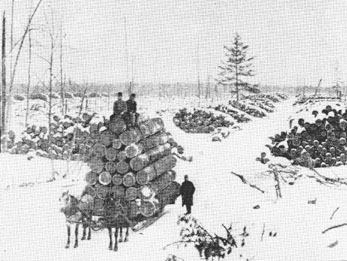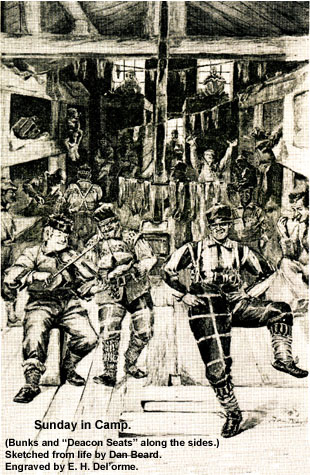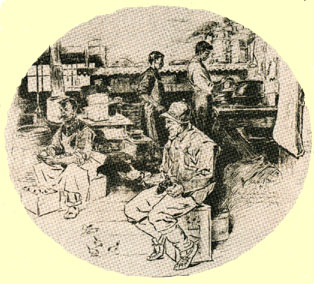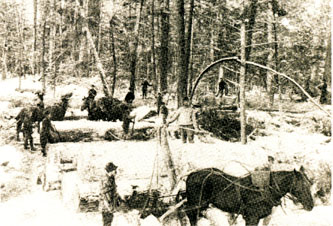LIFE IN A LUMBER CAMP by George Austin Woodward |
|
From: Munsey's Magazine, September 1894, pp. 604-10 Lumber camp life is by no means a desirable existence. Not only is it a dull routine of toil, but oftentimes it involves great hardship, while its pleasures are few and far between. A lake captain, who in his younger days spent several years in the woods, one day remarked to the writer that if he had his choice between spending three months in a lumber camp and the same amount of time in jail, he would unhesitatingly choose the latter. A camp usually consists of five buildings. The style of architecture is simple in the extreme, and strongly suggestive of puritanical origin. Long pieces of timber, neatly fitted together, constitute the body of each structure, the intervening chinks being filled with sticks and plastered with mortar. Boards about an inch in thickness, covered with tar paper, are used in construction of the roof and gable ends. Light enters the building through two small windows-one at each end--and ventilation is afforded by means of funnels placed on the roof. First in order of importance comes the "cook camp," which has two compartments--a kitchen and a dining room. Next to this is the "men's camp." First in order of importance comes the "cook camp," which has two compartments--a kitchen and a dining room. Next to this is the "men's camp." where the men sleep and spend the greater portion of their time when not at work. This consists of one large compartment. Two rows of bunks, one above the other, extend along its sides; each bunk is designed to accommodate two men. A long stationary bench is built on the front side of the lower bunks, and affords sufficient room to enable all to be seated at once. The sleeping capacity of a single camp is seldom sufficient for less than fifty, and not often for more than a hundred men. When the latter limit is exceeded, two sleeping camps are generally provided.
The "van," or "office" as it
is sometimes termed, is usually occupied by the scaler. It is a sort of
store, in which is kept a ful line of lumbermen's supplies-clothing,
boots, rubbers, tobacco, medicines, and all such articles as the men are
likely to need or call for. They are charged for what they choose to
purchase, and when the time arrives for "settling up" their van bill is
deducted from the amount they would otherwise receive. The quantity of
goods that are sold in a single season is anything but slight, and a
handsome profit is the result. As a rule, the foreman is a married man, in which case his family often occupies small dwelling in close proximity to the rest of the camp. Two more buildings--a commodious barn and a blacksmith shop--complete the list and require no description.
Camp customs, while many and varied, are
not so strictly
observed as they were a few years ago. In some camps, in the
evening, To those who are not used to the sight, a woodsman in the complete uniform of his craft is a ludicrous spectacle. His shirt and jacket are almost invariably made from a heavy woolen material called "mackinaw." As a general thing, his trousers do not differ from those worn by the city laborer, though a few wear full suits of mackinaw, in which garb a man looks very much as if he were walking about in his undergarments. Life in the logging camps is fraught with many dangers. Falling trees and rolling logs have caused a long list of deaths; and it is on this account that the woodsman's outer garments are of the brightest colors, blue, green, red, and yellow being the more prominent. The men are thereby able to see one another more distinctly through the thick underbrush, and by a timely warning to avert a great many dangers. It is not, therefore, as many suppose, a foolish eccentricity on their part to appear as "outlandish" as possible. Their feet and legs are incased in long woolen socks, usually a bright red, which are drawn over the trousers, and reach a little below the knee. At first glance, especially at a distance, the wearer appears as if he had on knee breeches. Cloth overshoes or rubbers are worn on the feet, except in wet weather, when high top leather boots are worn. And now, donning his mackinaw, a "coat of many colors," and pulling his Scotch cap well over his ears, the woodsman shoulders his axe and sallies forth long before the morning stars have finished their song. His personal property is kept in a canvas grain bag, which he calls his "turkey." Into this are promiscuously thrown all such articles as he does not wear or use. A piece of rope is attached to each end of the bag, and by placing it on his back and allowing the rope to pass over the shoulder and diagonally across the breast, he can carry his "turkey" for miles without fatigue. The food, or "chuck," as it is called, is plain but wholesome. Camps differ so much in this respect that no general regimen can be given. The chief drinks are tea and water, but a few camps provide coffee. Salted meat is the usual rule; only a limited number of camps furnish fresh meat. The following list will give the reader a good idea as to the kind of food: bread, butter, corn bread, crackers, potatoes, plain cake and cookies, doughnuts, bean soup, pea soup, rice soup, mince, apple, vinegar, prune and currant pies, bread pudding, pickles, prunes, pancakes with syrup, tea and sugar.
Iron knives and forks, tin dishes, plates and spoons grace the board of the lumber chopper. China dishes are considered a nuisance, and as the cook one day remarked, "would only be broken." The prevailing method of wiping the knives and forks is unique. Having been sufficiently washed, they are placed in a dry grain bag and thoroughly shaken. Then they are poured out upon the table, as clean and dry as the most scrupulous housewife could reasonably desire.
Etiquette is not the
woodsman's forte. At the table scarcely a word is spoken, save some such
expression as “Pass the butter, Bill!” or “Yank over a hunk o’ that ‘ar
meat, Jim.” The men are there to eat, and devote themselves to their task
with a wonderful singleness of purpose. Camps are usually organized during the summer or early in the fall. There is no fixed time, however, all depending on the amount of timber that is to be cut, and other circumstances. A suitable spot for locating the camp having been decided upon, tents are pitched, and the construction of the buildings is begun at once. In a week or ten days they are completed, and the work begins in earnest. The men are divided into gangs-choppers, skidders, and sawyers. The choppers go in advance, cutting the roads as they proceed. The sawyers follow close in their wake. A sawing crew consists of three men--a chopper and two sawyers. The chopper taking the lead, cuts niches in the trees on whatever side he wishes to fell them, and the sawyers, with their long, cross cut saw, cut them down. The chopper also severs the branches from the prostrate timber, and the sawyers cut it into logs, usually sixteen feet in length. The skidders take up the rear, a skidding crew consists of seven men and a team-three “swampers,” a teamster, and three “deckers.” Two long pieces of timber are first laid about eight feet apart, parallel to each other, and at right angles with the road. This is called the “skidway,” and its end comes within about six feet of the side of the road. The “swampers” trim the logs and make roads for the teamster by clearing away the thick underbrush. The teamster hauls the logs, and the deckers roll them into a pile varying from about four to ten feet high on the skidway. The advent of snow marks a new epoch in the history of camp work, and one that is much dreaded by the experienced woodsman; for the hours of labor are now decidedly increased. During the summer and fall his hours are regulated by rule, but in “hauling time” all is uncertainty. The work is mapped out, by the foreman; each day has its stint, which must be performed regardless of every drawback. Spring comes at last with its thaws and rains. The roads become spoiled, and the ice breaks up in the streams. By degrees the water slowly rises, and soon the logs begin to float. And now camp “breaks up.” unless there is a large quantity of timber to be cut for the next season. Some go home (if they are lucky enough to have a home); others repair to the nearest town to squander their hard earned “stake” in revelry. But the more industrious class join the “river crew“--a gang of men employed to drive the logs down the streams to the saw mills. This usually takes all summer, and sometimes lasts until late in the fall; so when the river crew disbands, its members return to camp.
Success or failure in
lumbering depends largely upon the weather. A fair amount of snow and a
low temperature are essential to the making of good roads. Sprinklers-- large tanks holding from fifty to seventy five barrels of
The introduction of the railroad in lumbering--an innovation of late years--has proved highly satisfactory in its results; the work is not only facilitated, but it is carried on the year round, for the lack of snow no longer constitutes a hindrance.
Explorations in Iowa History Project |

 singing, dancing, and rough games are kept up until a late hour. It is an
amusing sight--a couple of sets of
great, clumsy men dancing the quadrille or "stag dance," and keeping time
to the "tweedledee" of an old, squeaky fiddle, apparently having as good a
time as if they possessed every advantage of the modern ball room. Hazing,
which was a common practice a few years ago, is no longer tolerated to the
extent it once was. Formerly all newcomers must either sing a song or buy
a pound of tobacco-- a rule which, I am told, kept the drowd well supplied
with to luxury. Strangers were often subjected to a good deal of ill
treatment. A common practice was for six or eight men to seize another and
toss him up in a blanket. Stealing was practiced to such an extent that
socks were stolen from the feet of sleeping men.
singing, dancing, and rough games are kept up until a late hour. It is an
amusing sight--a couple of sets of
great, clumsy men dancing the quadrille or "stag dance," and keeping time
to the "tweedledee" of an old, squeaky fiddle, apparently having as good a
time as if they possessed every advantage of the modern ball room. Hazing,
which was a common practice a few years ago, is no longer tolerated to the
extent it once was. Formerly all newcomers must either sing a song or buy
a pound of tobacco-- a rule which, I am told, kept the drowd well supplied
with to luxury. Strangers were often subjected to a good deal of ill
treatment. A common practice was for six or eight men to seize another and
toss him up in a blanket. Stealing was practiced to such an extent that
socks were stolen from the feet of sleeping men. 

